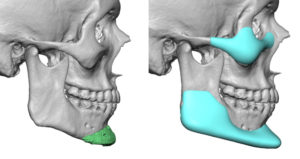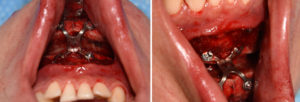
Custom jawline implants in my practice are very common. The three projecting points of the jawline (chin and jaw angles) are augmented and then connected as a single implant. The amount of chin augmentation can be considerable and attention has to be paid to the the overlying soft tissue chin pad and whether it can handle the implant load and adequately stretch over it. Horizontal increases up to 10mms are usually not a problem but greater advances than that can almost never be done unless one has a pre-existing chin implant. This serves to tissue expand the chin pad and allow for safe implant placement.
One approach to a large chin augmentation in custom jawline implants is to mesh a sliding genioplasty with a custom implant overlay as part of the rest of the jawline implant behind it. This lessens the ‘implant load’ in the chin area by making the augmentation partly done by the bone.
Case Study: This young male had an existing chin implant and he now desired both greater chin projection as well as an entire jawline augmentation. However he did not want the large chin augmentation to be done all by implant and requested a sliding genioplasty to replace the augmentation done by his existing chin implant . The additional chin augmentation was to be done by a jawline implant overlay. To match the midface shape to the larger jawline size, he also wanted custom infraorbital-malar implants.



The concept of combining a sliding genioplasty with an implant overlay is not new whether it is done by an isolated standard chin implant or a larger custom jawline implant. Computer designing makes the latter possible with a good fit between the bone and implant.
Case Highlights:
1) It is common to have custom infraorbital-malar and jawline implants placed during the same surgery for a maximal facial enhancement effect.
2) To limit the implant load on a large chin augmentation, a sliding genioplasty can be done with a custom jawline implant overlay.
3) Preoperative computer designing can make the amount of chin bone movement to fit into the implant overlay.
Dr. Barry Eppley
Indianapolis, Indiana





